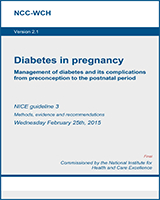From: 5, Antenatal care

Diabetes in Pregnancy: Management of Diabetes and Its Complications from Preconception to the Postnatal Period.
NICE Guideline, No. 3.
National Collaborating Centre for Women's and Children's Health (UK).
London: National Institute for Health and Care Excellence (UK); 2015 Feb.
Copyright © 2015 National Collaborating Centre for Women's and Children's Health.
NCBI Bookshelf. A service of the National Library of Medicine, National Institutes of Health.